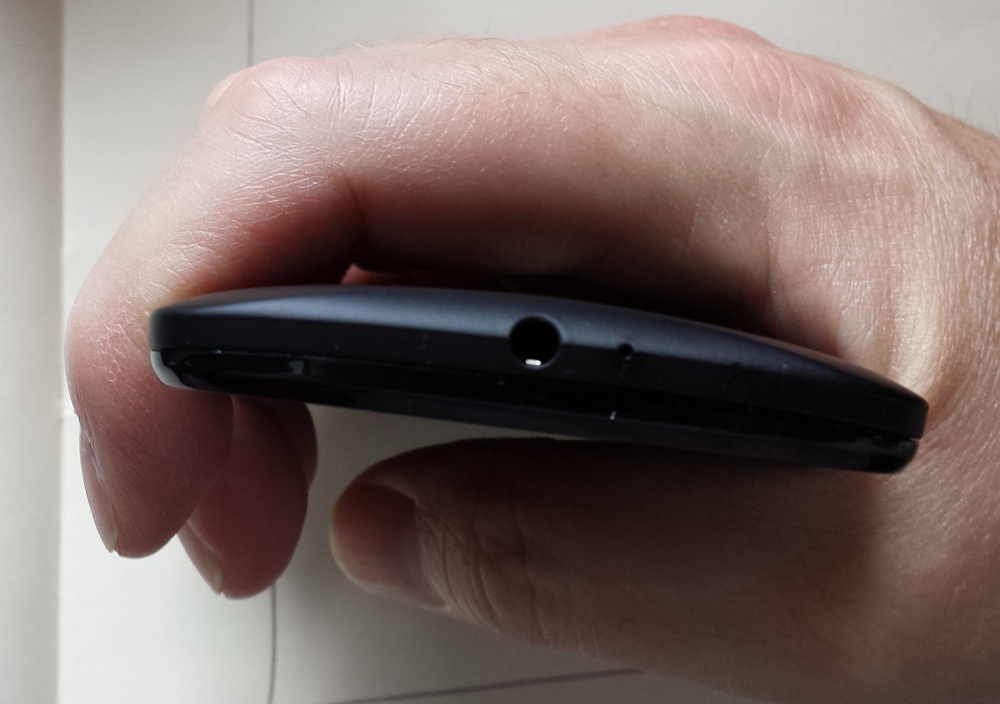Look, I get it, 'thickness' is an easily measured metric and few people want something in their hands that's an inch thick. So design teams around the globe have been dreaming up more and more ways to slim down smartphones until we reach the ridiculous 5.1mm figure above, on a smartphone with a screen that's 5" or so.
Why is the race to thin such a bad idea? 'Let me count the ways' (quoth not the Bard, for a change, but Elizabeth Barratt Browning, apparently):
- Comfort
Pick up any phone from five years ago (say a Nokia 5800) and your first thought will be 'This is so comfortable in the hand', most probably. (OK, your second thought will be 'How did I ever use this?', but I digress....!) You see, the thinner phones become, the 'sharper' their edges, and the larger they become, the more your fingers have to stretch to hold the device securely (see the photo below). The result is that large, ultra-thin phones are often uncomfortable and unwieldy to hold. Which brings me neatly to... - Dropability
From personal experience, I know that thin phones, gripped by their edges are droppable. I've lost count of the number of devices I've dropped in recent years because I was gripping them just on their sides. Famously, I dropped the Samsung Galaxy S II from head height onto tarmac five minutes after taking it out of the box (while trying to take a photo). Oops. And this brings us to... - Durability
When a phone does take a tumble, the thinner it is, the less stress pathways there are through the material and chassis and the more likely it is that a major component (e.g. the screen) will be damaged. - Battery compromises
Obviously, battery capacity is a function of device volume, so the thinner the phone is, the lower the battery capacity has to be, in general. In fact, there's a compensating factor, in that the larger surface area means that you can simply put in a flatter, larger capacity battery, but the principle still stands. And why not have a thicker, larger device with truly massive battery? A 2014 mass market 5"-screened Lumia should be able to sport a 3000mAh cell if it were 1mm thicker, a 4000mAh cell if it were 2mm thicker, etc. Which brings us to.... - Camera compromises
The thinner the phone, the less 'vertical' space the camera has to be squeezed in. Which means, for a given field of view, a smaller sensor has to be used. Plus there's less space for optics. Either way, the thinner a smartphone is, the more limited its camera must (by the laws of physics) be.
Against these, of course, there are all the many 'pros' for being super-thin:
- Coolness (maybe)
- Carryability (maybe)
Depending on plan form factor, a thinner phone creates less bulge in a pocket - assuming the device will fit in the pocket in the first place, not a given with today's 'phablets'...
Err... well, that's about it. In fact there aren't any other advantages I can think of to defend the 'race to thin'. As hinted above, it's somewhat reassuring that most of the Windows Phones I've handled come in at around the 10mm mark, implying some comfort, dropability, durability, a larger battery and decent camera. Phew. Even the latest Lumia 830 (which, to my mind, is a compromise too many) is 8.5mm thick, positively chunky by current Android and iOS standards.
And I'm happy that way. You see, the grip of the average human hand isn't designed for something wide and razor thin. Here, for example, is me holding the Lumia 1520, about as thin and wide as I hope Windows Phone ever gets, and in a normal, right-handed, one-handed grip:

Note the arch of the fingers over the back of the device - this is why ultra-thin phones feel less comfortable and easier to drop, since there are only contact points on the edges. Contrast this with the same grip around a smaller, more rounded device (the Motorola Moto G was to hand):

Again note two things. The narrower form factor (by a good centimetre) means that the device fits within the natural thumb arch and the first finger joint, making it easier to get the rest of the hand closer to the phone. And two, that the arched back of the phone itself is a better match for the arch of the fingers over it. Result? More contact and a more comfortable and more secure grip. Plus the other benefits listed above.
The Windows Phones released so far have straddled the form factor spectrum, but none have been thinner than about 8.5mm. The new Yezz Billy 4.7 threatens this, with a 7.2mm frame, mind you.
Of course, in two-handed use, the rules change slightly, but then if you're simply cradling a touchscreen device in your 'other' hand, then it could be anything, right up to a 7" tablet and it would still rest on your palm securely. I'm taking about holding a smartphone in one hand, e.g. while walking or talking - or, indeed walking and talking....
Maybe it's just me, maybe I'm going a little Spinal Tap, maybe a little Beautiful South, but given the advantages above, I rejoice in devices with slightly more modest sizes and greater curves. Just as with fashion models, too thin definitely isn't healthy from my runway vantage point in the mobile world.
